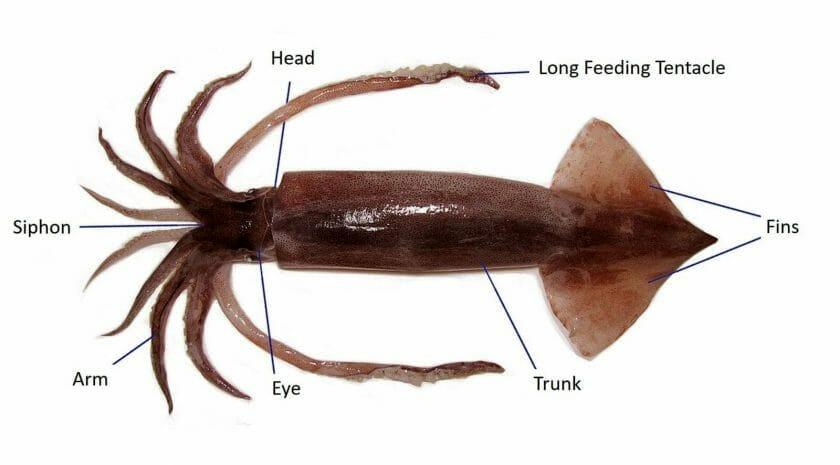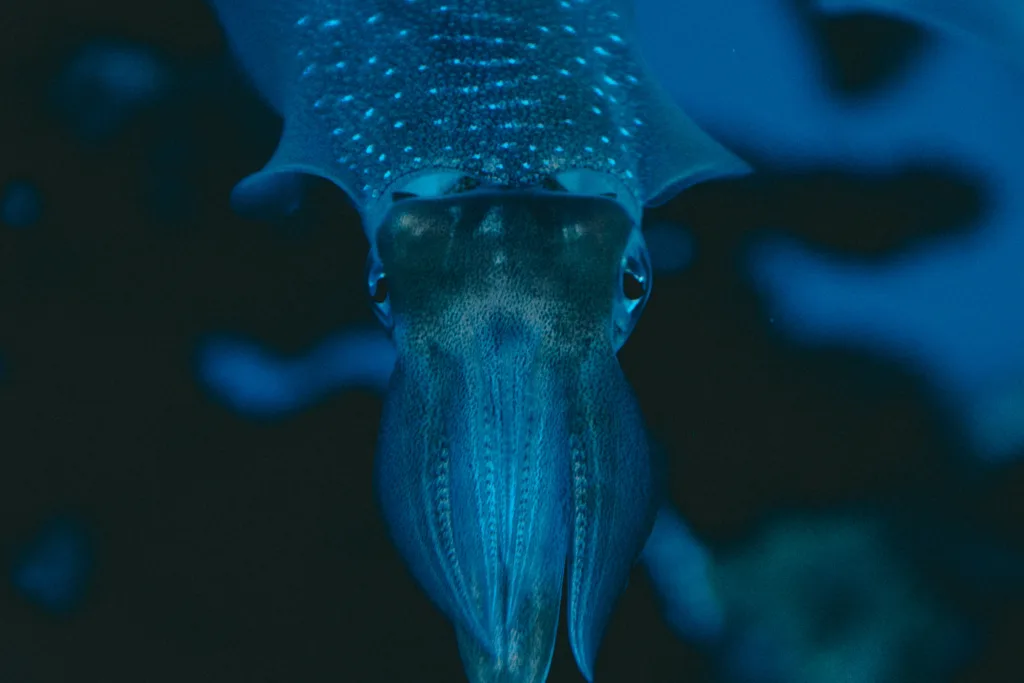Squids are fascinating creatures that have captured the imagination of humans for centuries. From their mysterious ability to change color to their impressive size, squid are some of the most intriguing animals of the sea. One question that often coes up when discussing squid is whether or not they have bones. In this blog post, we will explore the anatomy of squid and answer the question once and for all: does a squid have bones?
First, let’s dive into the anatomy of a squid. Squid are part of the cephalopod family, which includes octopus and cuttlefish. These animals have a distinct head, bilateral symmetry, and a mantle. They are mainly soft-bodied, like octopuses, but have a small internal skeleton in the form of a rod-like gladius or pen, made of chitin. The gladius is a stiff, supportive structure that runs the length of the squid’s body and gives it some rigidity.
However, the gladius is not technically a bone. Bones are made of calcium and phosphorus, while the gladius is made of chitin, a tough, fibrous material found in the exoskeletons of arthropods like insects and crustaceans. So while it serves a similar purpose as a bone, the gladius is not actually bone tissue.
So, to answer the question: does a squid have bones? No, squid do not have bones in the traditional sense. They do have a small internal skeleton in the form of a chitinous gladius or pen, which provides some support and structure to their bodies. However, the lack of bones is part of what makes squid so unique and flexible. Their hydrodynamic bodies allow them to move with ease through the water and capture prey with their eight arms and two longer tentacles.
Squid are fascinating animals with a unique anatomy that sets them apart from other sea creatures. While they may not have bones in the traditional sense, their chitinous gladius provides some support and structure to their bodies. Whether you’re a marine biologist or simply a curious ocean enthusiast, learning about the anatomy of squid is sure to inspire wonder and awe at the incredible diversity of life found in our oceans.
Do Squid and Octopus Have Bones?
Squids and octopuses are aquatic animals that belong to the phylum Mollusca, which also includes snails, slugs, and clams. Unlike humans and other vertebrates that have a skeletal system made up of bones, squids and octopuses have a hydrostatic skeleton. This means that they do not have bones, a backbone or a vertebral column.
A hydrostatic skeleton is a fluid-filled cavity that provides support and structure to the animal’s body. In squids and octopuses, this cavity is filled with seawater, which is incompressible. When the animal contracts its muscles, the water in the cavity is forced to move, causing the body to change shape and allowing the animal to move through the water. This system also alows the animal to keep its body parts rigid.
In summary, squids and octopuses do not have bones, but instead have a hydrostatic skeleton that allows them to move and maintain their shape in the water.

Source: earthlife.net
The Reason Why Squids Do Not Have Bones
Squids do not have bones because they belong to the group of invertebrates, which means that they lack a vertebral column or spine and other bones. Instead, squids have a unique structure known as a “pen” or “gladius,” which is a long, narrow, and translucent internal shell that provides support to their bodies. The pen is made of a tough and flexible material called chitin, which is similar to the material found in the exoskeletons of insects and crustaceans. The pen helps squids maintain their streamlined shape and allows them to swim and move quickly throuh the water. Additionally, not having bones allows squids to be more flexible and maneuverable, which is crucial for their survival in the ocean, where they must evade larger predators and catch their own prey.
Number of Bones in a Giant Squid
Giant squids, like all other squids, do not possess any structural bones. As invertebrates, they lack a skeletal system made up of bones. Instead, their bodies are supported by a structure known as a hydrostatic skeleton, which consists of fluid-filled cavities and muscles that work together to maintain the squid’s shape and allow it to move through the water with agility. Therefore, it can be concluded that giant squids have zero bones.
Skeletal Structure of a Squid
A squid has a small internal skeleton known as a gladius or pen, which is made of chitin. Unlike oter animals, such as mammals or reptiles, which have a bony skeleton, squid belong to a group of animals called cephalopods, which have evolved a different type of skeletal structure. The gladius is a long, thin, rod-like structure that runs through the mantle of the squid and provides support for its body. It is made of a hard, durable material that allows the squid to maintain its shape and move through the water with ease. The gladius also serves as an attachment point for the muscles that control the squid’s fins and tentacles.
Animals Without Bones
There are several animals that have no bones, and they are known as invertebrates. Some examples of invertebrates without skeletons are centipedes, millipedes, worms, jellyfish, octopuses, and squids. These animals are extremely flexible due to the absence of a rigid skeletal structure. Instead of bones, invertebrates have different structures that provide support and protection, such as exoskeletons, shells, or cartilage. Invertebrates without bones can be found in various habitats, from the depths of the ocean to the forest floor, and they play important roles in many ecosystems.
Do Squids Have Seven Hearts?
No, squids do not have 7 hearts. They have thee hearts, which is still quite unique compared to other animals. Two of these hearts are called branchial hearts and are responsible for pumping blood to the gills where oxygen is taken up. The third heart is called a systemic heart, which pumps the oxygenated blood to the rest of the body. The misconception that squids have 7 hearts may have arisen from the fact that they have a complex circulatory system with multiple chambers, which can be mistaken for separate hearts. However, it is important to note that squids only have three distinct hearts.
Does the Squid Experience Pain?
Recent research suggests that squid do possess specialized sensory receptors called nociceptors that selectively respond to noxious mechanical stimuli, indicating that they may be capable of experiencing pain. These nociceptors show long-lasting peripheral sensitization, which is similar to what happens in mammals when they experience pain. However, it is important to note that the subjective experience of pain is difficult to measure in non-human animals, and further research is needed to fully understand how squid perceive and respond to different types of stimuli.
Do Squids Experience Pain When Cut Alive?
According to a report by the University of British Columbia, cephalopods, including squids, have a highly developed nervous system, which suggests that they may be capable of experiencing pain and suffering. This means that when squids are cut alive, they may feel pain. However, it is important to note that the exact extent to which squids feel pain is still a topic of debate among scientists, and there is no clear consensus on the matter. Nevertheless, it is generally recommended to handle and process squids and oter cephalopods in a humane manner, to minimize any potential discomfort or suffering they may experience.
Do Squids Possess Reproductive Organs?
Yes, squids have a single testis, which is an internal organ located near the digestive system. The testis of a squid is long and tubular in shape, unlike the spherical testes found in many mammals. Squids use their testis to produce sperm, which is then transferred to a special arm called a hectocotylus and used to fertilize the female’s eggs during mating. It is important to note that the term “balls” is not commonly used to refer to the reproductive organs of squids, and using such terminology may cause confusion or misunderstandings.
Do Squid Have Six Hearts?
No, squid do not have six hearts. Squids actually have three hearts, which is still quite unique compared to other animals. One of the hearts, called the systemic heart, pumps blood throuhout the squid’s body, just like the single heart in most other animals. However, squids also have two additional hearts, called branchial hearts, which are responsible for pumping oxygenated blood through their gills. These three hearts allow squid to efficiently circulate oxygen and nutrients throughout their bodies, which is particularly important for their active, fast-moving lifestyle in the ocean. So, while squid do not have six hearts, their three hearts are still a fascinating adaptation that helps them thrive in their underwater environment.

Does a Squid Have Eight Hearts?
No, a squid does not have 8 hearts. Rather, a squid has three hearts. The two of these hearts are responsible for pumping blood to the gills where oxygen is obtained, while the third heart pumps the oxygenated blood throughout the rest of the squid’s body. This unique cardiovascular system allows squids to efficiently transport oxygen to all parts of their body, enabling them to survive in their aquatic environment.
Do Squids Have Teeth?
Yes, squids do have teeth. However, their teeth are not like the ones we have. Instead of having teeth in their mouth, squids have a radula, which is a tongue-like organ covered with rows of tiny teeth. The radula is located inside the squid’s sharp beak and is used to break down food into bite-sized pieces. The teeth on the radula are made of chitin, which is a tough and flexible material found in the exoskeletons of many invertebrates. The radula is an essential part of a squid’s digestive system and helps them to consume their prey efficiently.
Conclusion
In conclusion, squid are fascinating creatures that belong to the class Cephalopoda, which also includes octopuses and cuttlefish. They are invertebrates that lack a vertebral column or spine and other bones. Instead, they have a hydrostatic skeleton that allows them to keep their body parts rigid. Squid have eight arms and two longer tentacles for grasping prey, and a distinct head, bilateral symmetry, and a mantle. They are manly soft-bodied, like octopuses, but have a small internal skeleton in the form of a rod-like gladius or pen, made of chitin. Squid are known for their ability to change color and shape rapidly, which they use for camouflage and communication. They are also important in the food chain and are consumed by many marine animals, including humans. Overall, squid are fascinating creatures with unique adaptations and behaviors that continue to captivate scientists and nature enthusiasts alike.
